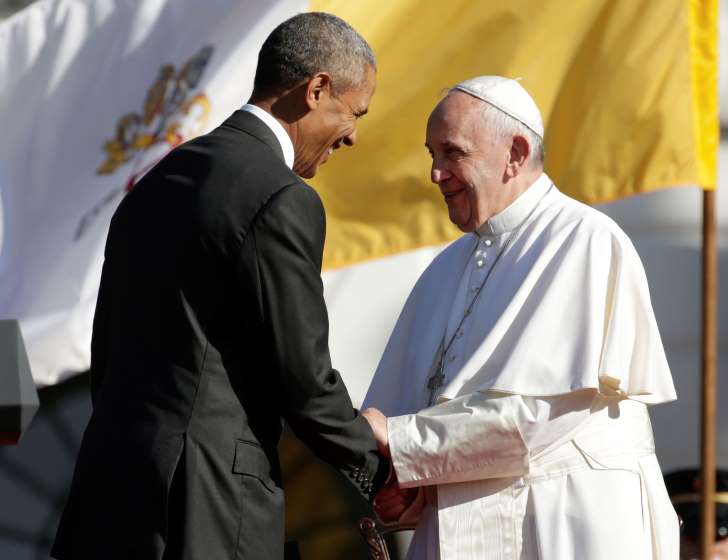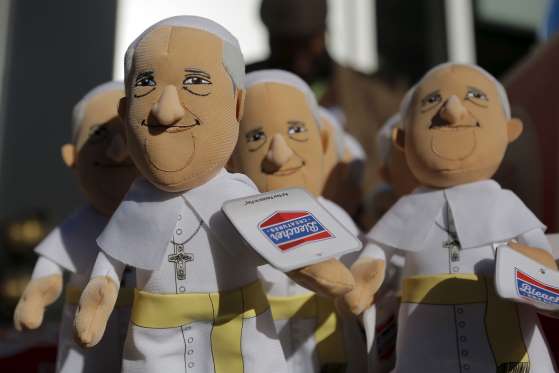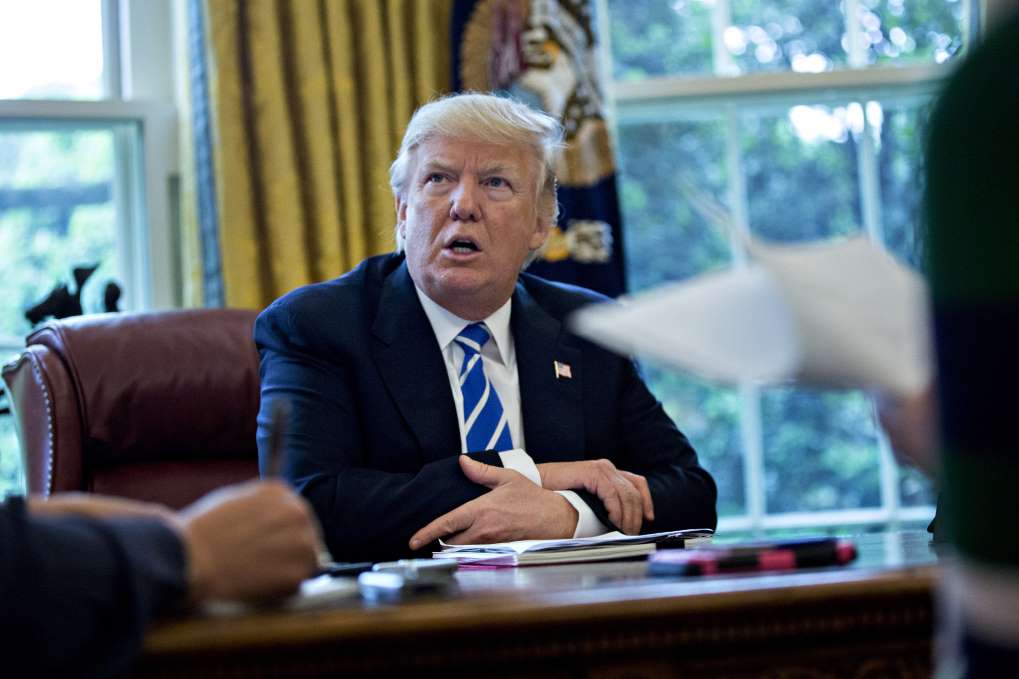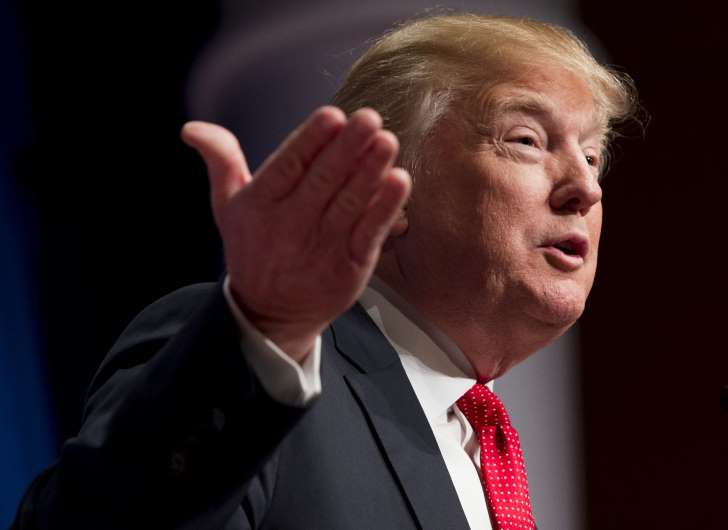September 23, 2015
WASHINGTON, DC – Jumping into the issues of the day, Pope Francis opened his visit to the United States with a strong call Wednesday for action to combat climate change, calling it a problem that "can no longer be left to a future generation.

September 23, 2015
WASHINGTON, DC – Jumping into the issues of the day, Pope Francis opened his visit to the United States with a strong call Wednesday for action to combat climate change, calling it a problem that "can no longer be left to a future generation.

President Barack Obama shakes hands with Pope Francis after this welcoming speech during the state arrival ceremony on the South Lawn of the White House in Washington, Wednesday, Sept. 23, 2015.
"President Barack Obama, in turn, hailed the pontiff as a moral force who is "shaking us out of our complacency" with reminders to care for the poor and the planet.
The White House mustered all the pageantry it had to offer as the pope arrived at the White House before an adoring crowd of thousands and a nation that seemingly cannot get enough of the humble pontiff who is rejuvenating American Catholicism while giving heartburn to some of its conservatives.
Speaking in a soft voice and halting English, Francis delivered a strong message against those who doubt the science of climate change, saying that the warming planet "demands on our part a serious and responsible recognition" of conditions awaiting today's children.
It was a message sure to delight the Obama White House, and liberals in general. But the pope's message had something for conservatives, too, with a pointed call to protect religious liberties — "one of America's most precious possessions."
"All are called to be vigilant,' he said, "to preserve and defend that freedom from everything that would threaten or compromise it."
That message was sure to be welcomed by many U.S. bishops and conservatives who have objected to the Obama administration's health care mandate and the recent Supreme Court legalization of same-sex marriage.
With flags snapping, color guard at attention and a military band's brassy marches, Francis stepped from his modest Fiat onto the South Lawn on a crisp fall morning that felt as optimistic as his own persona. Pope and president stood on a red-carpeted platform bedecked with red, white and blue bunting, standing at attention for the national anthems of the Hole See and the United States.

A man sells Pope Francis dolls on a street corner during the pope's visit to Washington on Sept. 23, 2015. Pope Francis and President Barack Obama are set to hold private talks at the White House on Wednesday before the pontiff parades through streets of Washington on the first full day of his first visit to the United States.
Just before the pope arrived, Obama had tweeted to the Holy Father: "Welcome to the White House, @Pontifex! Your messages of love, hope, and peace have inspired us all."
Obama, joking that his backyard is not typically so crowded, told the pope that the excitement surrounding his visit was a reflection of Francis' unique qualities, mentioning "your humility, your embrace of simplicity, the gentleness of your words and the generosity of your spirit."
The president singled out the pope's call for focusing on the poor and the marginalized, including refugees fleeing war and immigrants in search of a better life. The president also thanked the pope for his support for efforts to normalize relations between the U.S. and Cuba
After opening remarks on the lawn, the two leaders headed inside to the Oval Office for a one-on-one meeting where each hoped to find common cause with the other on issues they hold dear.
The pope later in the morning was to speak to America's bishops, an address that was highly anticipated given a certain disconnect between Francis' focus on social justice and a merciful church and the culture wars that America's bishops have waged in recent years over abortion and gay rights.
From the instant the white-robed and grinning Francis landed in the U.S. on Tuesday, doffed his skullcap in the breeze and clambered into his charcoal-gray Fiat, his visit has electrified wonky Washington, which can be jaded about the comings and goings of world figures.
Washington was the first stop on the pope's six-day, three-city visit to the United States.
People of all faiths wanted to be a part of it, from the hundreds on hand for his arrival at Andrews Air Force Base late Tuesday to the spectators outside the Vatican's diplomatic mission where the pope was staying to the throngs at the White House and the streets outside.
Kimberly Johnson, a 27-year-old medical student who lives in Washington, said she arrived outside the security gates at midnight in order to be the first one let into the sectioned-off viewing area that opened at 4 a.m.
"It's not just that he's the pope. He's a cool pope," Johnson said. "He's bringing the Catholic Church into the 21st century and making it a more accessible faith."
The pope took his time getting to the White House, stopping to greet schoolchildren who had gathered outside the Vatican's nunciature. The children took selfies with the pope, hugged him and waved Holy See flags.
Thousands more were gathering for a morning parade on streets near the White House.
For all of the oh-wow enthusiasm attending the visit, the pope and the president, with overlapping but far-from-identical agendas, had serious matters to attend to.
Even before he arrived for his first U.S. visit, Francis was fending off conservative criticism of his economic views. He told reporters on his flight from Cuba that some people may have an inaccurate impression that he is "a little bit more left-leaning."
"I am certain that I have never said anything beyond what is in the social doctrine of the church," he said.
As for conservatives who question whether he is truly Catholic, he added jokingly, "If I have to recite the Creed, I'm ready."
Obama was anxious to add oomph to his own efforts to combat climate change and fight income inequality, among other things, by finding common cause with the pope. But the two differ sharply on other issues, such as abortion and same-sex marriage.
From Francis' vantage point, his next stop after the White House was just as critical. The 78-year-old pontiff was meeting with America's 450-strong bishops' conference at the Cathedral of St. Matthew the Apostle.
Many U.S. bishops have struggled to come to terms with Francis' new social justice-minded direction of the church. Nearly all were appointed by Popes John Paul II and Benedict XVI. They prioritized drawing clearer boundaries for Catholic behavior and belief in the face of legalized abortion, advances in gay rights and the exodus of many Westerners from organized religion.
The American church spends hundreds of millions of dollars each year through its social service agencies, and for years has sought an overhaul of the immigration system to reunite families, shelter refugees and give the poor the chance at a better life. But the U.S. Conference of Catholic Bishops has increasingly put its resources behind high-profile fights over abortion, contraception and gay marriage.
Hailing from Argentina, the first pope from the Americas also was acting Wednesday to canonize a Spanish friar who brought the Catholic faith to California.
Francis was to celebrate the Mass of canonization for Junipero Serra in Spanish. Several thousand of the 25,000 tickets to the event were set aside for Spanish-speaking people, many from California. The Basilica of the National Shrine of the Immaculate Conception erected a temporary sanctuary on the east portico for the Mass.
On Thursday, Francis planned to deliver the first papal address ever to Congress, speaking to Republican-majority legislators deeply at odds with Obama on issues such as gay rights, immigration, abortion and climate change. Those same issues are roiling the early months of the presidential campaign.
Courtesy: AP















































































































